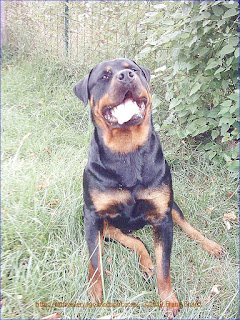




The bed was just free.........
would like you to look at yourself when you think that your dog’s behavior shows dominance. As loving dog owners we often teach a dog to behave in a certain way without even knowing it. We fuss them when they jump up or fail to train them properly whilst on the leash.
............your Rottweiler’s favorite seat in the house happens to also be yours. Can you blame them? Why do we like to sit on the furniture? Because it’s comfortable, right? Would you lay on the floor given the opportunity to sit on your comfortable couch or easy chair? No! What makes us think our dogs are going to feel any differently?
Then how, if our furniture is so comfortable and inviting, do we keep our dog from jumping onto it whenever they feel like being comfy too? How do you handle them jumping in our chairs when we catch them? Let’s look at the facts and figure out how to keep them off the couch.
Your dog wants to lay on the couch because it’s cozy. They also want to lay in your favorite chair because it smells like you. It is a comfort to them to be laying where you sit. This does not make it ok for them to do so.
You need to create a place for them to call their own. A place where they can feel warm and cozy. There needs to be an area in your home or in each of the rooms your dog has exposure to that is designated for their comfort where they can feel safe. Your furniture is so inviting because it’s comfortable, so make sure you have a blanket or a pillow they can call their own to lay on and be happy and comfortable. Keeping a blanket or pillow in each room your dog has access to can help prevent the desire to get on the furniture.
If you have a Rottweiler that guards possessions or even a space on the sofa then ask yourself, have you ever backed away from his guarding behavior? If so then you have taught him that it works, that by behaving this way he gets to keep the resource for longer. This type of guarding is all too often described as the act of a dominant dog leaving the dog completely misunderstood, when really the dog is only doing what he has learned to, in his life so far.
You do not need to establish dominance over your Rottweiler, you simply need to understand and communicate with him in a language that he understands. Surprisingly the usual rules for dominance training will actually cause confusion in your dog’s mind, because he is not a captive wolf and neither are you.
If the behaviour of your dog is challenging then it is vitally important that you understand exactly why he is doing it. By learning about canine communication signals, calming signals and signs of stress or anxiety you can get a really good idea of why your dog does what he does.

















































